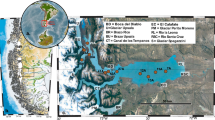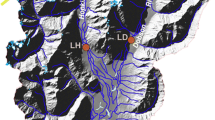Abstract
Lake La Cruz is a meromictic, karstic lake with annually laminated sediment formed by summer pulses of calcite deposition. The aim of this study was to explore the potential use of the laminated sediment from Lake La Cruz as a quantitative climate proxy, by calibrating lamina thickness against instrumental climate data. Statistical analysis of the relation between lamina thickness and the meteorological dataset indicated a high correlation between calcium carbonate lamina thickness and rainfall from December to March (r = 0.725, P < 0.01, n = 35). Winter rainfall anomalies in the area are, in turn, highly negatively correlated with the North Atlantic Oscillation index (NAO, r = −0.832; P < 0.01; n = 53). We propose a regression model to infer past winter rainfall from calcium carbonate laminae thickness. These results highlight new possibilities for paleoenvironmental research using calcite laminated sediment records as climate proxies, especially to study past rainfall variability.







Similar content being viewed by others
References
Alpert P, Ben-Gai T, Baharad A, Benjamini Y, Yekutieli D, Colacino M, Diodato L, Ramis C, Homar V, Romero R, Michaelides S, Manes A (2002) The paradoxical increase of Mediterranean extreme daily rainfall in spite of decrease in total values. Geophys Res Lett 29:Art. No. 1536
Brauer A (2004) Annually laminated lake sediments and their palaeoclimatic relevance. In: Fischer H, Kumke T, Lohmann G, Flöser G, Miller H, Von Storch H, Negendank JFW (eds) The climate in historical times. Towards a synthesis of Holocene proxy data and climate models. Springer, Berlin, pp 109–129
Brunskill GJ (1969) Fayetteville Green Lake, New York II: Precipitation and sedimentation of calcite in a meromictic lake with laminated sediments. Limnol Oceanogr 14:830–847
Camacho A, Picazo A, Miracle MR, Vicente E (2003) Spatial distribution and temporal dynamics of picocyanobacteria in a meromictic karstic lake. Arch Hydrobiol (Suppl Algol Stud) 109:171–184
De Geer G (1912) A geochronology of the last 12,000 years. Proc 11th Internat Geological Congress 1910:241–253
Dean W, Anderson R, Bradbury JP, Anderson D (2002) A 1500-year record of climatic and environmental change in Elk Lake, Minnesota I: Varve thickness and gray-scale density. J Paleolimnol 27:287–299
Dittrich M, Müller B, Mavrocordatos D, Wehrli B (2003) Induced calcite Precipitation by Cyanobacterium Synechococcus. Acta Hydrochim Hydrobiol 31:162–169
Dittrich M, Kurz P, Wherli B (2004) The role of autotrophic picocyanobacteria in calcite precipitation in an oligothrophic Lake. Geomicrobiol J 21:45–53
Esteban-Parra MJ, Rodrigo FS, Castro-Diez Y (1998) Spatial and temporal patterns of precipitation in Spain for the period 1880–1992. Int J Climatol 18:1557–1574
Itkonen A, Salonen VP (1994) The response of sedimentation in three varved lacustrine sequences to air temperatures, precipitation and human impact. J Paleolimnol 11:323–332
Janicot S (1996) Sahel droughts and ENSO dynamics. Geophys Res Lett 23:515–518
Johnson EA, Gutsell SL (1994) Fire frequency models, methods and interpretation. Adv Ecol Res 25:239–287
Johnson EA, Larsen CPS (1991) Climatically induced change in fire frequency in Southern Canadian Rockies. Ecology 72:194–201
Julià R, Burjachs F, Dasí MJ, Mezquita F, Miracle MR, Roca JR, Seret G, Vicente E (1998) Meromixis origin and recent trophic evolution in the Spanish mountain lake La Cruz. Aquat Sci 60:279–299
Kelts K, Hsü KJ (1978) Freshwater carbonate sedimentation. In: Lerman A (ed) Lakes. Geology, Chemistry, Physics. Springer Verlag, New York, pp 295–323
Kempe S, Degens EG (1979) Varves in the Black Sea and Lake Van (Turkey). In: Schlüchter C (ed) Morains and Varves. Balkema, Rotterdam, pp 309–318
Lamoureux SF (2001) Varve chronology techniques. In: Last WM, Smol JP (eds) Paleoenvironmental Research (DPER) Vol 2, Tracking environmental change using lake sediment: physical and geochemical techniques. Kluwer, pp 247–260
Lamoureux SF, Gilbert R (2004) A 750-yr record of autumn snowfall and winter storminess recorded in varved sediments of Bear Lake, Devon Island, Artic Canada. Quaternary Res 61:134–147
Leemann A, Niessen F (1994) Varve formation and climatic record in an Alpine proglacial lake: calibrating annually-laminated sediments against hydrological and meteorological data. The Holocene 4:1–8
Lotter AF, Birks HJB (1997) The separation of the influence of nutrients and climate on the varve time-series of Baldeggersee, Switzerland. Aquat Sci 59:362–375
Lotter AF, Sturm M, Teranes JL, Wehrli B (1997) Varve formation since 1885 and high-resolution varve analyses in hypertrophic Baldeggersee (Switzerland). Aquat Sci 59:304–325
Mangili C, Brauer A, Moscariello A, Naumann R (2005) Microfacies of detrital event layers deposited in Quaternary varved lake sediment of the Piànico-Sèllere Basin (northern Italy). Sedimentology 52:927–943
Martínez-Solares JM, Mezcua J (2002) Catalogo sísmico de la Península Ibérica (880 a.c.–1900). Monografía Num. 18. Instituto Geográfico Nacional, Ministerio de Fomento
Megard RO (1968) Planktonic photosynthesis and the environment of calcite carbonate deposition in lakes. Interim Rept 2, Limnol Res Center, U Minn
Miracle MR, Camacho A, Julià R, Vicente E (2000) Sinking processes and their effect on the sedimentary record in the meromictic Lake La Cruz (Spain). Verh Int Verein Limnol 27:1209–1213
Nipkow F (1920) Vorläufige Mitteilungen über Untersuchungen des Schlammabsatzes in Zürichsee. Z Hydrol 1:1–27
O’Sullivan PE, Moyeed R, Cooper MC, Nicholson MJ (2002) Comparison between instrumental observational and high resolution proxy sedimentary records of Late Holocene climate change- a discussion of possibilities. Quaternary Int 88:27–44
Rocha A (1999) Low-frequency variability of seasonal rainfall over the Iberian Peninsula and ENSO. Int J Climatol 19:889–901
Rodo X, Baert E, Comin FA (1997) Variations in seasonal rainfall in Southern Europe during the present century: relationships with the North Atlantic Oscillation and the El Niño-Southern Oscillation. Cimate Dynamics 13:275–284
Rodrigo MA, Vicente E, Miracle MR (1993) Short-term calcite precipitation in the karstic meromictic Lake La Cruz (Cuenca, Spain). Verh Int Verein Limnol 25:711–719
Rodrigo MA, Vicente E, Miracle MR (2001) The meromictic Lake La Cruz (Central Spain): Patterns of stratification. Aquat Sci 63:406–416
Rodriguez-Pascua MA, Calvo JP, de Vicente G, Gomez-Gras D (2000) Soft-sediment deformation structures interpreted as seismites in lacustrine sediments of the Pre-Betic Zone, SE Spain, and their potential use as indicators of earthquake magnitudes during the Late Miocene. Sed Geol 135:117–135
Rodriguez-Puebla C, Encinas AH, Nieto S, Garmendia J (1998) Spatial and temporal patterns of annual precipitation variability over the Iberian Peninsula. Int J Climatol 18:299–316
Romero L, Camacho A, Vicente E, Miracle MR (2006) Sedimentation patterns of photosynthetic bacteria based on pigment markers in meromictic Lake La Cruz (Spain): Paleolimnological implications. J Paleolimnol 35:167–177
Seibold E (1958) Jahreslagen in Sedimenten der Mittleren Adria. Geol Rundschan 47:100–117
Shiki T, Kumon F, Inouchi Y, Kontani Y, Sakamoto T, Tateishi M, Matsubara H, Fukuyama K (2000) Sedimentary features of the seismo-turbidites, Lake Biwa, Japan. Sed Geol 135:37–50
Teranes JN, McKenzie JA, Bernasconi SM, Lotter AF, Sturm M (1999) A study of oxygen isotopic fractionation during bio-induced calcite precipitation in eutrophic Baldeggersee, Switzerland. Geochim Cosmochim Acta 63:1981–1999
Thompson JB, Schultze-Lam S, Beveridge TJ, Des-Marais DJ (1997) Whiting events: biogenic origin due to the photosynthetic activity of the cyanobacterial picoplankton. Limnol Oceanogr 42:133–141
Vicente E, Miracle MR (1988) Physicochemical and microbial stratification in a meromictic karstic lake of Spain. Verh Internat Verein Limnol 23:522–529
Zolitschka B (1996) Processes of recent sedimentation in a High Arctic lake, northern Ellesmere Island, Canada. J Paleolimnol 16:169–186
Acknowledgements
We are very grateful to the INM (Spanish Institute of Meteorology) which kindly provided the meteorological data. We gratefully acknowledge two anonymous reviewers for their comments on an earlier version of the manuscript and M. Brenner for the English revision. This work has been financed by CICyT grant REN2002-03272 CLI and CGL2005-04040/BOS from the Spanish Ministry of Education and Science to M.R. Miracle and E. Vicente, respectively. L. Romero-Viana was supported by a scholarship from Generalitat Valenciana.
Author information
Authors and Affiliations
Corresponding author
Rights and permissions
About this article
Cite this article
Romero-Viana, L., Julià, R., Camacho, A. et al. Climate signal in varve thickness: Lake La Cruz (Spain), a case study. J Paleolimnol 40, 703–714 (2008). https://doi.org/10.1007/s10933-008-9194-6
Received:
Accepted:
Published:
Issue Date:
DOI: https://doi.org/10.1007/s10933-008-9194-6




